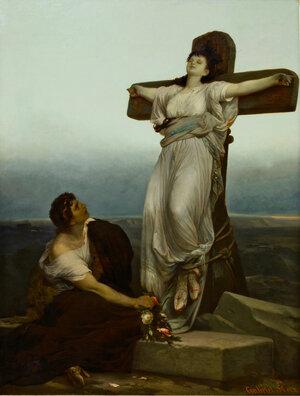Frye Favorites is a series in which members of the Frye’s staff and community share their perspectives on memorable exhibitions and works from the Museum’s collection.
This post features Mark Eddington, the Museum’s exhibition preparator, who retired in May 2021 after working at the Frye for twenty-five years. Mark’s role included the installation and de-installation of exhibitions; he also used his intimate knowledge of the Museum’s collection to support its conservation and care.
“I started working at the Frye around one day a week in 1996, when the Museum’s collection was in storage. Richard West [director from 1994-2003] was reviewing the collection, prioritizing which pieces he wanted to show in his opening exhibition, and figuring out which of those might need conservation work for the paintings or the frames. He was doing weekly reviews of that kind, and I was first brought on to help with that. I'd pull the paintings out of the racks in storage and set them up. He'd review them, make some notes, and then I would put them back.
Then, they hired an exhibition designer, and he realized he was going to need some help with getting the first big exhibition installed in the museum in early 1997. And, I've been here ever since. I slowly got more hours, and became more involved with the exhibitions and collections departments.

George Inness’s Campagna, Italian Landscape (ca. 1874) is one of my favorites from the collection. I don't remember when I first saw it, but it’s been shown in the Museum’s salon hangings during the last few years. I like nocturne landscape painting in general, especially from that era—Tonalists and the Hudson River School painters, who Inness was influenced by to some degree. I like Whistler's Nocturne paintings a bit, too. And, this is different from those, but there are some similarities. I very much like the indistinct, soft focus of the painting. It's kind of mysterious. You can't tell really whether it's dawn or dusk. There's a moon rising or setting, and a shepherd and flock in the foreground. But, it's low light, so things are fairly indistinct. And there are some pretty bright colors in it, but the light makes for a subdued kind of painting and mood.
Gabriel von Max. The Christian Martyr, 1867. Oil on paper mounted on canvas. 48 x 36 3/4 in. Founding Collection, Gift of Charles and Emma Frye, 1952.116. Photo: Spike Mafford

Gabriel von Max. The Christian Martyr, 1867.
Oil on paper mounted on canvas. 48 x 36 3/4
in. Founding Collection, Gift of Charles and
Emma Frye, 1952.116. Photo: Spike Mafford
I'd appreciated landscape painting before I came here, but my main interest in art was American abstract painting of the twentieth century. So, at first it felt kind of funny to be working at a museum that was really involved in, at that time almost exclusively, representational work. There were a lot of painters in the collection I'd never heard of before, like Gabriel von Max. I knew very little about him until we had the solo show on his work. After I saw the paintings from Germany that were part of the exhibition, I realized I really liked his work. I thought there were some really strong, great paintings.
I've also met a lot of great people over the couple of decades I worked here. And, I've really enjoyed being involved with an institution that's a nonprofit, that does something for the public at-large, that's not involved with the marketplace. There's an entertainment aspect to it, but it's educational and I really just think that the Frye's a great institution, and that art museums in general are very important.”
Mark Eddington
Exhibition Preparator
(as told to Erin Langner)